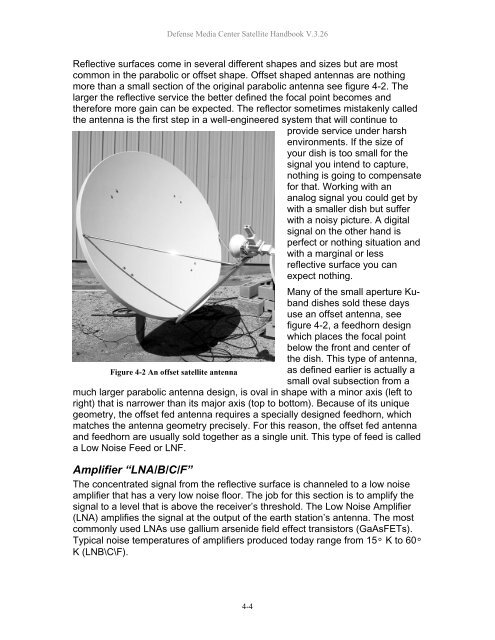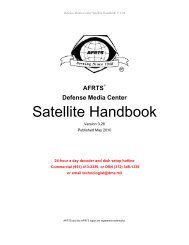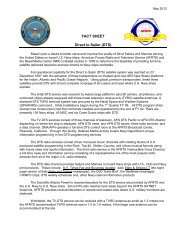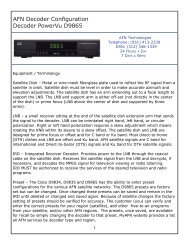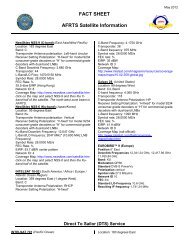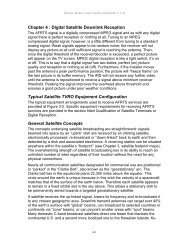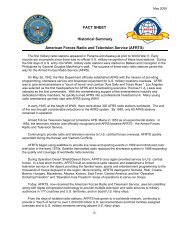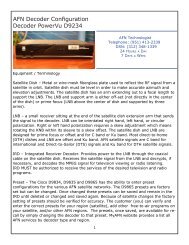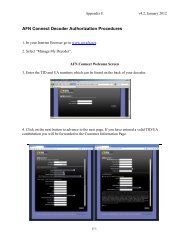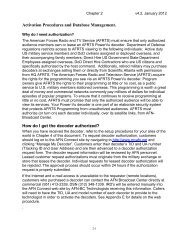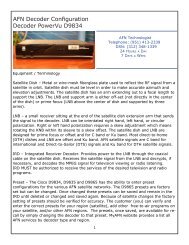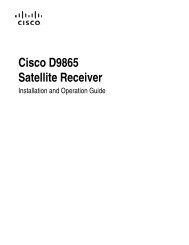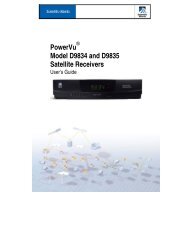AFRTS Defense Media Center Satellite Handbook
AFRTS Defense Media Center Satellite Handbook
AFRTS Defense Media Center Satellite Handbook
Create successful ePaper yourself
Turn your PDF publications into a flip-book with our unique Google optimized e-Paper software.
<strong>Defense</strong> <strong>Media</strong> <strong>Center</strong> <strong>Satellite</strong> <strong>Handbook</strong> V.3.26<br />
Reflective surfaces come in several different shapes and sizes but are most<br />
common in the parabolic or offset shape. Offset shaped antennas are nothing<br />
more than a small section of the original parabolic antenna see figure 4-2. The<br />
larger the reflective service the better defined the focal point becomes and<br />
therefore more gain can be expected. The reflector sometimes mistakenly called<br />
the antenna is the first step in a well-engineered system that will continue to<br />
provide service under harsh<br />
environments. If the size of<br />
your dish is too small for the<br />
signal you intend to capture,<br />
nothing is going to compensate<br />
for that. Working with an<br />
analog signal you could get by<br />
with a smaller dish but suffer<br />
with a noisy picture. A digital<br />
signal on the other hand is<br />
perfect or nothing situation and<br />
with a marginal or less<br />
reflective surface you can<br />
expect nothing.<br />
Many of the small aperture Kuband<br />
dishes sold these days<br />
use an offset antenna, see<br />
figure 4-2, a feedhorn design<br />
which places the focal point<br />
below the front and center of<br />
the dish. This type of antenna,<br />
Figure 4-2 An offset satellite antenna<br />
as defined earlier is actually a<br />
small oval subsection from a<br />
much larger parabolic antenna design, is oval in shape with a minor axis (left to<br />
right) that is narrower than its major axis (top to bottom). Because of its unique<br />
geometry, the offset fed antenna requires a specially designed feedhorn, which<br />
matches the antenna geometry precisely. For this reason, the offset fed antenna<br />
and feedhorn are usually sold together as a single unit. This type of feed is called<br />
a Low Noise Feed or LNF.<br />
Amplifier “LNA/B/C/F”<br />
The concentrated signal from the reflective surface is channeled to a low noise<br />
amplifier that has a very low noise floor. The job for this section is to amplify the<br />
signal to a level that is above the receiver’s threshold. The Low Noise Amplifier<br />
(LNA) amplifies the signal at the output of the earth station’s antenna. The most<br />
commonly used LNAs use gallium arsenide field effect transistors (GaAsFETs).<br />
Typical noise temperatures of amplifiers produced today range from 15° K to 60°<br />
K (LNB\C\F).<br />
4-4


